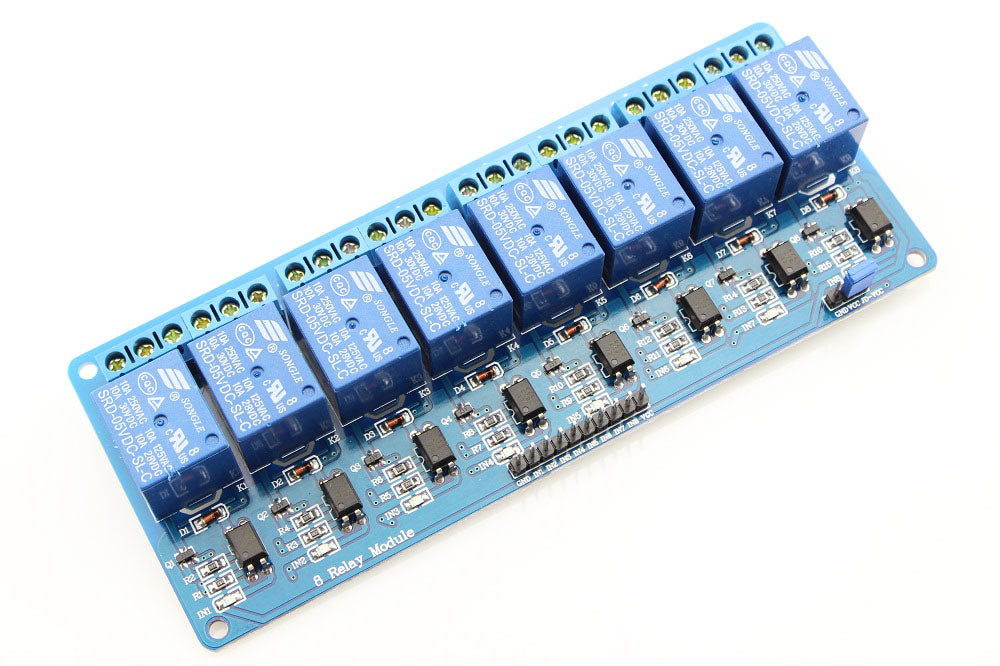Relay Module 10A 8 Channel
Relay Module 10A 8 Channel -You may use a relay in controlling high-voltage and current that your Arduino could not, may it be AC or DC. This 8 channel relay can handle voltages of 10A@250VAC or 10A@30VDC.. A relay is a digital switch. What it does is to allow a current to flow or not using the signal is received. It has 3 terminals, the Common, Normally Open, and, Normally Close Terminal. It also has 1 coil that does the cutting or letting the current flow.
Circuit Rocks brings the 8-Channel Isolated 5V 10A Relay Module for users who desire to implement some unique microcontrollers in projects. The digital switch is controlled by a greater range of microcontrollers, including Arduino, AVR, PLC, ARM, and PIC, etc. The unit is capable of handling plenty of appliances and other equipment that reflect large currents. When it comes to considering the relay output maximum contact, it appears as AC250V 10A and DC 5V 10A.
As for the terminals, the Common Terminal and the usually Close Terminal have continuity without energizing the coil. Energizing the coil, the Common Terminal, and the Normally Open Terminal creates the continuity and cuts the connection to the Normally Close Terminal.
If you need a fewer set of the relay, we have the 1 channel, 2 channel, 4 channel. For more channels here is the 16 channel version.
QUICK SPECS:
- Control Voltage: 5V DC
- Max Control Capacity:10A@250VAC or 10A@30VDC
Furthermore, the 8-channel relay module hosts 3 terminals such as the Common, Normally Closed, and Normally Open. The dedicated single-coil helps cut and let the current flow follows its prescribed path. The most astonishing part is that it presents itself with a comprehensive range of applications. One can derive the services of the Relay Module for all MCU control, smart home control, PLC control, and industrial sector.
Enthusiasts can switch to this sort of 10A relay module on Raspberry Pi. This neat relay mechanism houses 8 x 5V relays rated at 10A/250V each. There are 8 channels on the board to give you access to multiple units to be the best fit for Arduino and Raspberry Pi projects. It is a 5V 8-channel Relay Module with a Normally Open interface. Further, the module reflects a trigger current of 5mA as well as a module working voltage of DC 5V. A jumper triggers every single channel of the module to adjust the setting across high and low levels.
Relay Module 8-Channel – Features
The relay module is designed in a way that it will not move even upon the disconnection of the control line. The status indicators are presented in terms of green and red color lights. The green-color light indicates the power utilization while the red-color light indicates the 6-channel relay status. It allows users to connect all module-size interfaces through the terminal block. Thus, it seems quite practical and convenient.
In terms of features, the 8-channel system publishes a remarkable blend of valuable features and specifications. Some of the key highlights are as given below:
- First, the 8-channel Relay Module has the ability to control both AC and DC appliances i.e. motor, solenoids, lights, and fans, etc.
- It equips an LED status indicator to convey the relay ON/OFF status.
- Also, it brings mounting holes for installation.
- There’re high-quality screw terminals for easy and quick connection establishment.
- It has the potential to control directly all kinds of equipment and load.
- Further, the relay module houses the Input Signal Pin to burg stick for convenient accessibility.
- It provides a signal input for a high-level signal.
- Moreover, it also offers the facility to protect your microcontroller with a freewheeling diode.
- Users can open a normally closed contact.
- It is more convenient to execute the Blue KF301 terminal line.
- Likewise, the relay module controls various sorts of appliances and other equipment.
Frequently Asked Questions
Q1: How is the Relay put to use?
Q2: What varieties of relay modules are there?
Relay Module 10A 8 Channel
Relay Module 10A 8 Channel
Out of stock
Product Code
SKU:AB352
Couldn't load pickup availability






